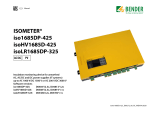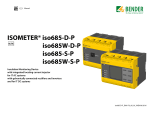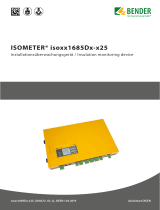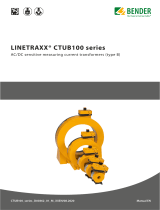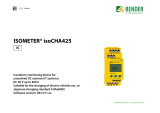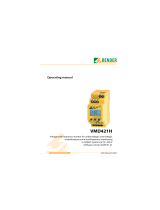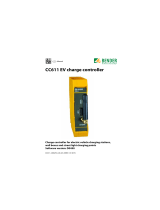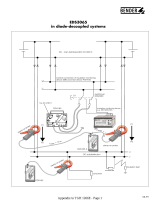Page is loading ...

Manual
EN
EDS3090
…91, …92, …96
EDS195P
ISOSCAN®
I
s
I
n
ALARM
I
n
I
s
INFO
MENU
HOLD
RESET
ESC
OK
Portable equipment for insulation fault location
for energised and deenergised AC and DC systems
Software version: D399 V2.1
EDS309x_D00012_05_M_XXEN/12.2017

Bender GmbH & Co. KG
P.O.Box 1161 • 35301 Grünberg • Germany
Londorfer Straße 65 • 35305 Grünberg • Germany
Tel.: +49 6401 807-0 • Fax: +49 6401 807-259
E-mail: [email protected] • www.bender.de
© Bender GmbH & Co. KG
All rights reserved.
Reprinting only with permission
of the publisher.
Subject to change!
Photos: Bender archives and bendersystembau archives.

3
Table of Contents
EDS309x_D00012_05_M_XXEN/12.2017
1. Important information ........................................................................................... 7
1.1 How to use this manual ......................................................................................................... 7
1.2 Technical support: Service and support .......................................................................... 8
1.2.1 First level support .................................................................................................................... 8
1.2.2 Repair service ............................................................................................................................ 8
1.2.3 Field service ................................................................................................................................ 8
1.3 Training courses ....................................................................................................................... 8
1.4 Delivery conditions ................................................................................................................. 9
1.5 Inspection, transport and storage ..................................................................................... 9
1.6 Warranty and liability ............................................................................................................. 9
1.7 Disposal ....................................................................................................................................... 9
1.8 Overview of chapters ........................................................................................................... 10
2. Safety instructions ............................................................................................... 11
2.1 General safety instructions ................................................................................................ 11
2.2 Intended use ........................................................................................................................... 11
2.3 Device-specific safety instructions ................................................................................. 11
3. System description .............................................................................................. 13
3.1 System components ............................................................................................................13
3.1.1 Overview of system components ................................................................................... 13
3.1.2 Insulation fault location equipment type list ............................................................. 14
3.1.3 Accessories .............................................................................................................................. 15
3.2 Function of the system components ............................................................................. 16
3.2.1 Locating current injector PGH18… ................................................................................ 16
3.2.2 Insulation fault locator EDS195PM ................................................................................. 16
3.2.3 Measuring clamps ................................................................................................................. 16
3.2.4 Coupling device AGE185 .................................................................................................... 17
3.3 Operating principle for insulation fault location (IΔL) ............................................. 17
3.3.1 Schematic diagram EDS system ...................................................................................... 18
3.3.2 Test cycle .................................................................................................................................. 18
3.3.3 Definitions ............................................................................................................................... 19
3.3.4 Currents in the EDS system ............................................................................................... 19
3.4 Operating principle for residual current measurement (IΔn) ............................... 20

Table of Contents
4EDS309x_D00012_05_M_XXEN/12.2017
4. Considerations prior to use ................................................................................ 21
4.1 How does the equipment for insulation fault location work ................................ 21
4.2 Requirements for reliable insulation fault location ................................................... 22
4.3 Reduced locating current ................................................................................................... 24
4.4 Response sensitivity characteristics of the EDS195PM ............................................ 24
4.4.1 Response characteristics for main circuits in 3AC systems .................................... 26
4.4.2 Response characteristics for main circuits in AC systems ....................................... 27
4.4.3 Response characteristics for main circuits in DC systems ....................................... 27
4.4.4 Response characteristics for control circuits in AC systems ................................... 28
4.4.5 Response characteristics for control circuits in DC systems .................................. 28
5. Connecting the locating current injector ....................................................... 29
5.1 Disconnecting insulation monitoring device .............................................................. 29
5.2 Locating current injector in an electrically isolated IT system .............................. 29
5.3 Connection to a live IT system .......................................................................................... 30
5.4 Connection to a PV system ................................................................................................ 31
6. Operation ............................................................................................................... 33
6.1 Short description of insulation fault location (EDS mode) ..................................... 33
6.1.1 Commissioning the PGH18… for locating current injection ................................. 33
6.1.2 Insulation fault location using EDS195PM ................................................................... 33
6.2 Detailed description of insulation fault location ........................................................ 33
6.3 Description of a residual current measurement ......................................................... 33
6.4 Displays and controls on the PGH18… ......................................................................... 34
6.5 Displays and controls on the EDS195PM ...................................................................... 35
6.6 Operating the EDS195PM ................................................................................................... 36
6.6.1 Switching on and off the device ...................................................................................... 36
6.6.2 Changing the measuring clamp ....................................................................................... 37
6.6.3 Improved legibility due to display lighting .................................................................. 37
6.6.4 Changing between insulation fault location IΔL and
residual current measurement IΔn operating modes .............................................. 37
6.6.5 Quickly checking the response values for IΔL and IΔn ............................................ 37
6.6.6 Checking Info menu ............................................................................................................. 37
6.6.7 Significance of the display elements .............................................................................. 38
6.7 Standard displays on the EDS195PM ............................................................................. 39
6.7.1 EDS measurement (IΔL) ....................................................................................................... 39
6.7.1.1 Standard display if there is no cable to be measured in the clamp ............. 39
6.7.1.2 Standard display for EDS measurement (IΔL) with cable in the clamp ....... 39
6.7.1.3 Standard display for measuring faults or pauses between changes in polarity
of the measuring pulse ................................................................................................. 39

Table of Contents
5
EDS309x_D00012_05_M_XXEN/12.2017
6.7.2 RCM measurement (IΔn) .................................................................................................... 39
6.7.2.1 Standard display for RCM measurement (IΔn) with cable in the clamp .... 39
6.8 Alarms during EDS measurement or RCM measurement ...................................... 40
6.9 Indication of device and measuring errors .................................................................. 40
6.10 Factory settings EDS195PM (state as supplied) ......................................................... 41
6.11 Menu structure ...................................................................................................................... 42
6.11.1 Navigating in the menu ...................................................................................................... 43
6.11.2 Menu item: Settings ............................................................................................................. 43
6.11.3 Menu item: System .............................................................................................................. 44
6.11.4 Menu item: Harmonics ........................................................................................................ 44
6.11.5 Menu item: IΔL alarms ......................................................................................................... 44
6.11.6 Menu item: IΔn logger ........................................................................................................ 45
6.12 Practical usage ....................................................................................................................... 45
6.12.1 Insulation fault location in a system without a permanently installed EDS
system ....................................................................................................................................... 45
6.12.2 Insulation fault location in a system with a permanently installed EDS system ..
48
6.12.3 Insulation fault location in diode-decoupled DC systems ..................................... 50
6.12.4 Usage of the EDS195PM as a residual current meter ............................................... 52
6.12.5 Indication of the harmonics during residual current measurement .................. 53
6.13 Coupling device AGE185 for higher system voltages ............................................. 54
6.14 Power supply for the EDS195PM ..................................................................................... 55
6.14.1 Displaying charge state ...................................................................................................... 55
6.14.2 Changing batteries ............................................................................................................... 55
6.14.3 Power supply unit supplied .............................................................................................. 55
7. Technical specifications ...................................................................................... 56
7.1 Technical specifications for the system EDS309… ................................................... 56
7.2 Technical specifications PGH18… .................................................................................. 56
7.3 Technical specifications EDS195PM ............................................................................... 57
7.4 Technical specifications measuring clamps ................................................................ 58
7.5 Technical specifications AGE185 ..................................................................................... 59
7.6 Standards and certifications ............................................................................................. 59
7.7 Dimension diagrams ............................................................................................................ 60
7.8 Status word ............................................................................................................................. 61
7.9 Ordering data including accessories ............................................................................. 62
7.10 Component list ...................................................................................................................... 63

6EDS309x_D00012_05_M_XXEN/12.2017
8. Frequently Asked Questions .............................................................................. 64
9. Additional fault location information using the EDS309x ........................... 65
9.1 Required equipment: ........................................................................................................... 65
9.2 IRDH575B2- 435........................................................................................... (B91065503) 65
9.3 Collecting and analysing information ........................................................................... 65
9.4 Taking measurements ......................................................................................................... 66
INDEX ...........................................................................................................................71

7
EDS309x_D00012_05_M_XXEN/12.2017
1. Important information
1.1 How to use this manual
Always keep this manual within easy reach for future reference.
To make it easier for you to understand and revisit certain sections in this manual, we have used sym-
bols to identify important instructions and information. The meaning of these symbols is explained
below::
DANGER
The signal word indicates that there is a high risk danger that will result in elec-
trocution or serious injury if not avoided.
WARNING
This signal word means that there is a medium risk of danger that can lead to
death or serious injury, if not avoided.
CAUTION
This signal word indicates a low level risk that can result in minor or moderate
injury or damage to property if not avoided.
This symbol denotes information intended to assist the user
to make optimum use of the product.
This manual is intended for qualified personnel working in electrical engineering
and electronics!

Important information
8EDS309x_D00012_05_M_XXEN/12.2017
1.2 Technical support: Service and support
For commissioning and troubleshooting Bender offers you:
1.2.1 First level support
Technical support by phone or e-mail for all Bender products
Questions concerning specific customer applications
Commissioning
Troubleshooting
1.2.2 Repair service
Repair, calibration, update and replacement service for Bender products
Repairing, calibrating, testing and analysing Bender products
Hardware and software update for Bender devices
Delivery of replacement devices in the event of faulty or incorrectly delivered Bender devices
Extended warranty for Bender devices with in-house repair service or replacement device at no
extra cost
1.2.3 Field service
On-site service for all Bender products
Commissioning, parameter setting, maintenance, troubleshooting for Bender products
Analysis of the electrical installation in the building (power quality test, EMC test, thermogra-
phy)
Training courses for customers
*Available from 7.00 a.m. to 8.00 p.m. 365 days a year (CET/UTC+1)
**Mon-Thurs 7.00 a.m. - 8.00 p.m., Fr 7.00 a.m. - 13.00 p.m.
1.3 Training courses
Bender is happy to provide training regarding the use of test equipment.
The dates of training courses and workshops can be found on the Internet at www.bender-de.com -
> Know-how -> Seminars.
Telefone: +49 6401 807-760*
Fax: +49 6401 807-259
In Germany only: 0700BenderHelp (Tel. and Fax)
E-Mail: support@bender-service.de
Telefone: +49 6401 807-780** (technical issues)
+49 6401 807-784**, -785** (Sales)
Fax: +49 6401 807-789
E-Mail: [email protected]
Telefone: +49 6401 807-752**, -762** (technical issues)
+49 6401 807-753** (Sales)
Fax: +49 6401 807-759
E-Mail: fieldservice@bender-service.de
Internet: www.bender.de

Important information
9
EDS309x_D00012_05_M_XXEN/12.2017
1.4 Delivery conditions
Bender sale and delivery conditions apply. For software products, the "Softwareklausel zur Überlas-
sung von Standard-Software als Teil von Lieferungen, Ergänzung und Änderung der Allgemeinen
Lieferbedingungen für Erzeugnisse und Leistungen der Elektroindustrie" (software clause in respect
of the licensing of standard software as part of deliveries, modifications and changes to general de-
livery conditions for products and services in the electrical industry) set out by the ZVEI (Zentralver-
band Elektrotechnik- und Elektronikindustrie e.V.) (German Electrical and Electronic Manufacturers'
Association) also applies.
Sale and delivery conditions can be obtained from Bender in printed or electronic format.
1.5 Inspection, transport and storage
Inspect the dispatch and equipment packaging for damage, and compare the contents of the pack-
age with the delivery documents. In the event of damage in transit, please contact Bender immedi-
ately. The devices must only be stored in areas where they are protected from dust, damp, and spray
and dripping water, and in which the specified storage temperatures can be ensured.
1.6 Warranty and liability
Warranty and liability claims in the event of injury to persons or damage to property are excluded if
they can be attributed to one or more of the following causes:
Improper use of the device.
Incorrect mounting, commissioning, operation and maintenance of the device.
Failure to observe the instructions in this operating manual regarding transport, commission-
ing, operation and maintenance of the device.
Unauthorised changes to the device made by parties other than the manufacturer.
Non-observance of technical data.
Repairs carried out incorrectly and the use of replacement parts or accessories not approved by
the manufacturer.
Catastrophes caused by external influences and force majeure.
Mounting and installation with device combinations not recommended by the manufacturer.
This operating manual, especially the safety instructions, must be observed by all personnel
working on the device. Furthermore, the rules and regulations that apply for accident preven-
tion at the place of use must be observed.
1.7 Disposal
Abide by the national regulations and laws governing the disposal of this device. Ask your supplier
if you are not sure how to dispose of the old equipment.
The directive on waste electrical and electronic equipment (WEEE directive) and the directive on the
restriction of certain hazardous substances in electrical and electronic equipment (RoHS directive)
apply in the European Community. In Germany, these policies are implemented through the "Elec-
trical and Electronic Equipment Act" (ElektroG). According to this, the following applies:
Electrical and electronic equipment are not part of household waste.
Batteries and accumulators are not part of household waste and must be disposed of in accord-
ance with the regulations.
Old electrical and electronic equipment from users other than private households which was
introduced to the market after 13th August 2005 must be taken back by the manufacturer and
disposed of properly.
For more information on the disposal of Bender devices, refer to our homepage at www.bender.de
-> Service & support.

Important information
10 EDS309x_D00012_05_M_XXEN/12.2017
1.8 Overview of chapters
1. How to get the most out of this manual:
This chapter provides information about using this documentation.
2. Safety instructions:
This section provides information about risks affecting installation and operation.
3. System description:
In this chapter you will find an overview of the system components, a description of their func-
tion and the basic principles of insulation fault location.
The principle of residual current measurement is described in the final section.
4. Considerations prior to use:
This chapter describes the practical aspects of insulation fault location and provides numerous
characteristic curves for assessing the response values to be set.
5. Connecting the locating current injector:
The connection of the PGH18… to a system to be tested is described here.
6. Operation:
This chapter contains a description of the graphical user interface on the EDS195PM. There is
also an illustration of the menu structure as well as illustrations of the various standard dis-
plays.
You will also find information of the supply of power to the EDS195PM here.
7. Technical specifications:
Along with tabular data this chapter contains information on standards and the dimensions of
the system components.
8. Frequently Asked Questions:
Use this chapter to quickly identify and rectify any malfunctions that occur.
9. INDEX:
Use the index to quickly find the desired keywords.

11
EDS309x_D00012_05_M_XXEN/12.2017
2. Safety instructions
2.1 General safety instructions
Part of the device documentation in addition to this manual is the enclosed "Safety instructions for
Bender products."
2.2 Intended use
The portable insulation fault location system EDS309… is used to locate insulation faults in IT sys-
tems. All variants are suitable for the measurement of residual currents in TN and TT systems. The
EDS3096PG is particularly suitable for insulation fault location in electrically isolated systems.
Please observe the limits on the area of application stated in the technical specifications, as well as
the measuring categories for the measuring clamps used. If, in the specific case, measuring current
transformers other than the measuring clamps supplied are used with the EDS195PM, attention is to
be paid to ensuring the connection wires and transformer have an adequate nominal insulation volt-
age (overvoltage category, see Technical specifications)
Use which deviates from or is beyond the scope of these technical specifications is considered non-
compliant.
2.3 Device-specific safety instructions
Only skilled persons are permitted to carry out the work necessary to install, com-
mission and run a device or system.
CAUTION
System interference and high system leakage capacitances can degrade the ac-
curacy of the measurement.
CAUTION
Hazard due to excessively high locating current or excessively high
locating voltage!
An excessively high PGH18… locating current may damage sensitive loads (e.g.
in control circuits) or trigger unintended switching processes. For this reason
select a lower locating current for these systems (1 or 10 mA).
For instance it is only allowed to use the EDS3091 or EDS3091PG in systems with
programmable logic controllers (PLCs).
The locating voltage of DC 50 V produced by the locating current injector
PGH186 can cause interference at sensitive system components. In case of
doubt, contact Bender.
The locating current from the PGH185 or PGH186 can cause residual current de-
vices to trip. The locating current is limited to maximum 25 mA (or 10 mA), how-
ever 30 mA residual current devices may trip, for instance, between 15 and 30
mA.

13
EDS309x_D00012_05_M_XXEN/12.2017
3. System description
3.1 System components
On page 63, you will find a detailed overview of the scope of delivery of the EDS309x versions. The
following illustration provides a choice of the possible components.
3.1.1 Overview of system components
The primary task of the EDS309… is insulation fault location in IT systems. For this purpose the
individual components of the EDS309… are used in combination.
1Aluminium case with handle
2Measuring clamp PSA3020 (main circuits) or PSA3320 (control circuits)
Clamp inside diameter 20 mm
3Locating current injector PGH18…
For generating a locating current for insulation fault location
4Insulation fault locator EDS195PM
For connecting measuring clamps and for finding insulation faults
5Measuring clamp PSA3052 (main circuits) or PSA3352 (control circuits)
Clamp inside diameter 52 mm
PSA3020
PGH186
100mA
M
10mA
25mA
Imax
ON
ON
Us
L1(+)
L2(-)
L3
3(N)AC 0...575V mit/with 500...790V
DC 0...504V AGE185 400...960V
PSA3052
MESSZANGE / CLAMP ON PROBE
Datenblatt / Datasheet : TGH1320
Durchmesser / Diameter : 52 mm
Art.-Nr. / Art.-no. : B 980 694
max. 1 A
600 V CAT III
1000 mA / 0,1 mA ~
123
45
EDS195PM
ISOSCAN®
I
L
I
n
ALARM
I n
I
L
INFO
MENU
HOLD
RESET
ESC
OK

System description
14 EDS309x_D00012_05_M_XXEN/12.2017
3.1.2 Insulation fault location equipment type list
It is possible to undertake a residual current measurement in TT and TN systems (earthed systems)
using all the device variants listed below.
The following overview describes which measuring tasks can be undertaken with which models:
Equipment for insulation fault location in main circuits
1. Permissible system voltage in the main circuits:
– Insulation fault location in IT systems up to AC 42…460 Hz, 20…575 V and DC 20…504 V
– Insulation fault location using AGE185 up to AC 42…460 Hz, 500…790 V and DC 400…960 V
EDS3090:
Can be used in IT systems in which a locating current injector PGH471 or an IRDH575 is already
installed.
EDS3090PG:
Can be used in IT systems in which neither a locating current injector PGH471 nor an IRDH575 is
already installed.
Supply voltage for the locating current generator PGH185 supplied:
AC 50…60 Hz, 230 V
EDS3090PG-13:
Can be used in IT systems in which neither a locating current injector PGH471 nor an IRDH575 is
already installed.
Supply voltage for the locating current generator PGH185-13 supplied:
AC 50…60 Hz, 90…132 V
2. Permissible system voltage in the main circuits:
– Insulation fault location in IT systems up to AC 42…460 Hz, 0…575 V and DC 0…504 V
– Insulation fault location using AGE185 up to AC 42…460, Hz 500…790 V and DC 400…960 V
EDS3096PG:
Can be used in IT systems in which neither a locating current injector PGH471 nor an IRDH575 is
already installed.
Supply voltage for the locating current generator PGH186 supplied:
AC 50…60 Hz, 230 V
Insulation fault location, also in IT systems electrically isolated on all poles
EDS3096PG-13:
Can be used in IT systems in which neither a locating current injector PGH471 nor an IRDH575 is
already installed.
Supply voltage for the locating current generator PGH186-13 supplied:
AC 50…60 Hz, 90…132 V
Insulation fault location, also in IT systems electrically isolated on all poles
EDS3096PV:
Applicable in PV systems without a locating current injector installed.
Supply voltage for the delivered locating current injector PGH186: AC 50…60 Hz, 230 V.
Insulation fault location, also in IT systems disconnected on all poles or in de-energised IT sys-
tems.

System description
15
EDS309x_D00012_05_M_XXEN/12.2017
Accessories CTAFxxx:
Set with flexible clamps with band lengths of 500 and 1000 mm
Application for cables with bigdimensions or in systems with narrow space conditions
Combinable with EDS3090, EDS3092, EDS3096
The minor response sensitivity towards the clamps PSA3... in chapter 4.4 must be considered.
Equipment for insulation fault location in control circuits
Permissible system voltage in the control circuits:
Insulation fault location in IT systems up to AC 42…460 Hz, 20…265 V and DC 20…308 V.
EDS3091:
Can be used in IT systems in which a locating current injector PGH473 or an IRDH575 is already
installed.
EDS3091PG:
Can be used in IT systems in which neither a locating current injector PGH473 nor an IRDH575 is
already installed.
Supply voltage for the locating current generator PGH183 supplied:
AC 50…60 Hz, 230 V
EDS3091PG-13:
Can be used in IT systems in which neither a locating current injector PGH473 nor an IRDH575 is
already installed.
Supply voltage for the locating current generator PGH183-13 supplied:
AC 50…60 Hz, 90…132 V
Equipment for insulation fault location in main circuits and control circuits
EDS3092PG:
Contains the components and combines the features of the EDS3090PG and EDS3091PG
3.1.3 Accessories
You will find information on the standard accessories as well as on optional accessories in the order-
ing data on page 62 and in the component list on page 63.
For series WF… current transformers you will need a BNC to PS2 adapter cable, see page 62.
Only use the components supplied by us on working with the EDS309…. Com-
mercially available measuring clamps are not allowed to be used! This state-
ment also applies to measuring clamps or measuring current transformers from
the Bender range that are not expressly intended to be used with the EDS309….
Along with the measuring clamps supplied, it is allowed to connect to the
EDS195PM the following measuring current transformers from the Bender series:
WF…
W… /WR… /WS…
W…-8000/WS…-8000
Series W…AB current transformers cannot be used!

System description
16 EDS309x_D00012_05_M_XXEN/12.2017
3.2 Function of the system components
3.2.1 Locating current injector PGH18…
The PGH18… generates a defined locating current. The magnitude of the current is dependent on
the insulation fault present and the system voltage.
The PGH185 or PGH186 limits the locating current to maximum 25 mA or maximum 10 mA
depending on the switch setting.
The PGH183 limits the locating current to maximum 2.5 mA or maximum 1 mA depending on
the switch setting.
The PGH186 applies the locating current in electrically isolated IT systems or in IT systems with
a system voltage < 50 V using an integrated voltage source (DC 50 V). In IT systems with a sys-
tem voltage > 50 V the existing voltage in the system is used to drive the locating current.
3.2.2 Insulation fault locator EDS195PM
The insulation fault locator EDS195PM has the following measuring functions:
Insulation fault location I∆L (EDS mode) for use in IT AC or DC systems:
– Either as a component of the portable equipment for insulation fault location EDS309…
– Or as an additional insulation fault locator in permanently installed equipment for insulation
fault location with IRDH575 or PGH1… as well as EDS46…/49….
Residual current measurement I∆n (RCM mode) for usage in TN or TT AC systems. The response
value range can be found in table 3.1 on page 16.
Response value
The response value is defined by the sensitivity of the EDS195PM. This value can be set in both DC
and AC and 3AC IT systems as an arithmetic mean in accordance with Tabelle 3.1 auf Seite 16. System
interference and high system leakage capacitances can degrade the accuracy.
3.2.3 Measuring clamps
Measuring clamps measure the locating current or the residual current. They have a test lead approx.
2 m long. The connection to the EDS195PM is made using a BNC connection.
The following table summarises the most important data for the usage of the different measuring
clamps.
Tab. 3.1: Measuring clamps and response values for the EDS195PM
If measuring current transformers are used instead of measuring clamps, you will need the adapter
supplied: BNC/4-mm connector. See table on page 63.
Main circuit
(EDS3090…, 3092…, 3096…)
Control circuit
(EDS3091…)
IT system
Measuring
clamps CTAF-SET PSA3320, PSA3352
Measuring range 10...50 mA 0.2…5 mA
Response value 2…10 mA, ±30% / ±2 mA 0.2…1 mA, ±30 % / ±0.2 mA
TN/TT system
Measuring
clamps PSA3020, PSA3052, PSA3165 PSA3320, PSA3352
Measuring range 5 mA…10 A 2 mA…2 A
Response value 10 mA…10 A 5 mA…1 A

System description
17
EDS309x_D00012_05_M_XXEN/12.2017
3.2.4 Coupling device AGE185
The coupling device AGE185 expands the nominal voltage range of the equipment for insulation
fault location EDS309…. It enables the equipment to be connected to system nominal voltages up
to AC 790 V or DC 960 V.
3.3 Operating principle for insulation fault location (IΔL)
On the occurrence of the first insulation fault in IT systems a residual current flows that is essentially
defined by the system leakage capacitances. The basic concept of fault location is therefore to briefly
close the fault circuit using a defined resistance. With this principle a locating current is provided by
the system voltage and this locating current contains a signal that can be evaluated.
The locating current is generated periodically by the locating current injector PGH18… (part of the
EDS309…PG system).
The locating current can also be generated by an iso685-D-P, isoxx1685xP, IRDH575 or a locating cur-
rent injector PGH47….
The amplitude and duration of the locating current is limited. During this process the system con-
ductors are alternately
connected to earth via a defined resistance. The locating current produced as a result is dependent
on the magnitude of the insulation fault present and the system voltage.
For example the locating current on the EDS3090 is limited to maximum 25 mA; with the setting
Imax = 10mA it is limited to 10 mA. During planning it is to be ensured that there are no system com-
ponents in which this locating current could cause a reaction involving damage in unfavourable cir-
cumstances.
The locating current pulse flows from the locating current injector through the live conductors to the
insulation fault by the shortest route. From there it flows via the insulation fault and the earth cable
(PE cable) back to the locating current injector. This locating current pulse is detected by the meas-
uring clamps or measuring current transformers in the insulation fault path and is indicated by the
insulation fault locator EDS195PM connected.
You must ensure that all live conductors are routed through the measuring
clamp. Do not route any protective earth conductors or screens on
screened cables through the measuring clamp! Commercial measuring
clamps are not suitable for the EDS309… and must not be used.
Only if these notes are observed will you obtain a correct measurement result.
You will find additional information in our technical information Techinfo08
"Transformer installation".

System description
18 EDS309x_D00012_05_M_XXEN/12.2017
3.3.1 Schematic diagram EDS system
3.3.2 Test cycle
The locating current pulse cycle has a duration of 6 seconds. The PGH… sends alternating positive
and negative locating current pulses. The sketch below shows the test cycle of the PGH… with the
different switch settings (1, 2, 3) on the device, see schematic diagram above.
EDS195PM Insulation fault locator
PGH… Locating current injector
UnIT system voltage
PSA… Measuring clamp
RFInsulation fault
PE Protective earth conductor
UnIT system
PSA...
EDS195PM
PGH...
PE
RF
L2(L-)
L1(L+)
2
3
1
EDS Start
Position
PGH... 12331
2 sec 4 sec 2 sec 4 sec

System description
19
EDS309x_D00012_05_M_XXEN/12.2017
3.3.3 Definitions
IL= Locating current that flows through the locating current injector while the fault location
is running (EDS mode).
I∆L= Locating current measured by the insulation fault locator (EDS mode).
I∆n= Residual current produced by an insulation fault (RCM mode).
3.3.4 Currents in the EDS system
As an addition to the schematic diagram on page 18, here the path of the residual currents and the
locating current is shown:
The following residual currents flow through the measuring current transformer of the
EDS195PM:
The locating current caused by the insulation fault RF-N
The residual currents I∆n that flow through the system leakage capacitances CE-V and
CE-N, or that are caused by RF-V and RF-N
Transient leakage currents that are caused by switching and control activities in the system
Low-frequency leakage currents generated by the use of converters
............. Locating current circuit due to the insulation fault RF-N
. .. .. .. Residual currents I∆n (example)
I∆LLocating current measured by the EDS195PM
CE-V Upstream capacitances, system leakage capacitances upstream of the
measuring current transformer
CE-N Downstream capacitances, system leakage capacitance downstream of
the measuring current transformer
RF-V Insulation fault upstream of measuring current transformer
RF-N Insulation fault downstream of the measuring current transformer
UnIT system PSA...
EDS195PM
PE
R
F-N
R
F-V
C
E-N
C
E-V
PGH... 12
3
In
IL
IL

System description
20 EDS309x_D00012_05_M_XXEN/12.2017
3.4 Operating principle for residual current measurement (IΔn)
In the RCM mode the EDS309… operates based on the principle of residual current measurement. In
this case only the insulation fault locator EDS195PM and a measuring clamp are used, the locating
current injector PGH18… is not required.
As per Kirchhoff's law the sum of the currents flowing into any node in a network is equal to the sum
of the currents flowing out.
Abb. 3.1: The two currents Izu and Iab have the same magnitude, however their signs are different,
such that the sum of the two currents is zero. The EDS195PM detects this situation, there is no message.
Abb. 3.2: Part of the current flows through an insulation fault RF. The sum of the two currents
is no longer zero. As soon as the residual current reaches or exceeds the response value
there is an alarm message on the EDS195PM.
In the RCM mode it is possible to measure residual currents in single and three-
phase TT or TN systems. If the system leakage capacitance ahead of the measur-
ing clamp is sufficiently high, the EDS195P can also be used for measurements in
single and three-phase IT systems. The suitability of the device is to be checked in
the specific case.
EDS195PM
ISOSCAN®
I
L
I
n
ALARM
I n
I
L
INFO
MENU
HOLD
RESET
ESC
OK
II
I
EDS195PM
ISOSCAN®
I
L
I
n
ALARM
I n
I
L
INFO
MENU
HOLD
RESET
ESC
OK
II
I
/

